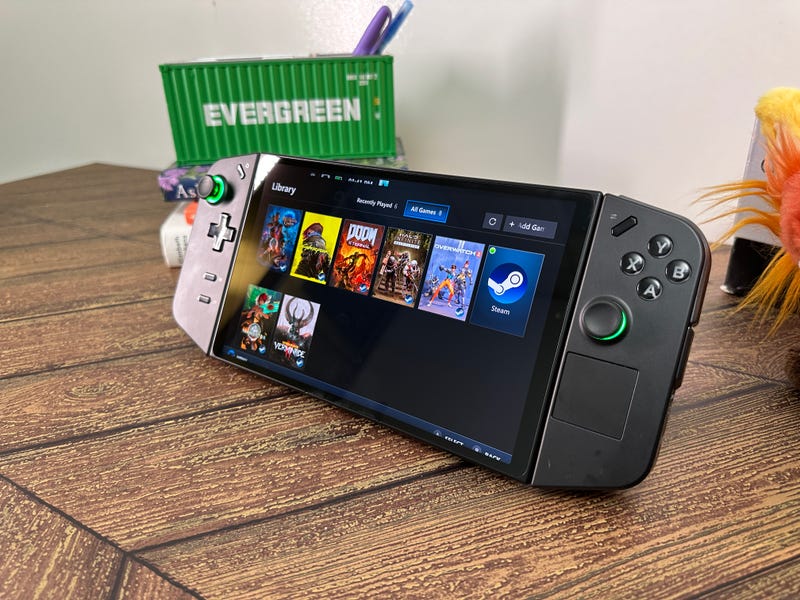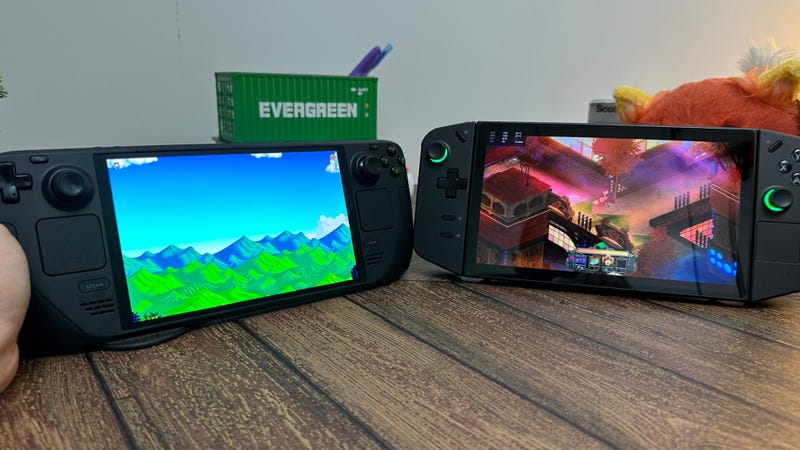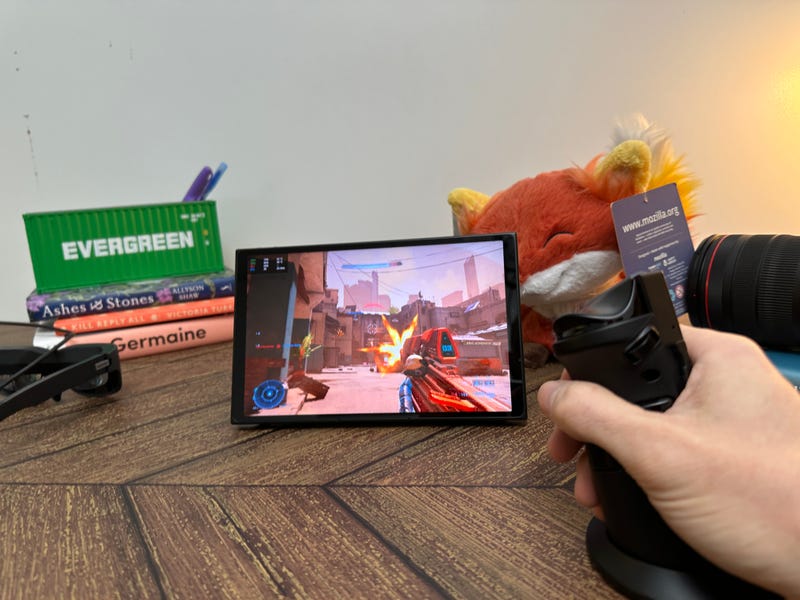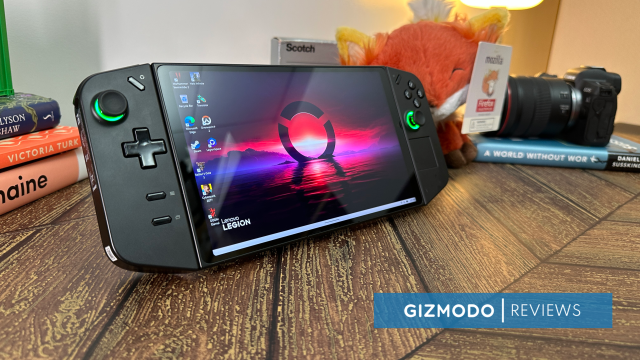I can’t help but feel bad for the Legion Go. Lenovo’s first take on the handheld console market is a strong one. It’s got a much bigger screen than the original Steam Deck. It has a better battery than the original Steam Deck. Thanks to its pop-out controllers, it’s more innovative than the Steam Deck or the Asus ROG Ally. Most importantly, it packs more power than the original Steam Deck.
Notice how I keep saying “original.” That’s because Valve has thrown a wrench into the works by releasing a new OLED Steam Deck that, by every definition, is an improvement on the original handheld that came out close to two years ago. That new Deck has thrown the entire ecosystem out of whack, and now Lenovo’s newest console has to compete on unequal footing. The new deck has a better screen than the Go and comparable battery life. Plus, the new Deck is far lighter than Lenovo’s offering.
What does not help is that the Legion Go is not a straightforward device. It can run some games far better than even the new Deck can, but not every game is as specifically optimised for Lenovo’s device (looking at you, Cyberpunk: 2077). Its attempts at innovation with its detachable controllers and special “FPS Mode” are fun novelties but not necessary for this gaming machine.
Rather than simply copying the Steam Deck, I want to give props to Lenovo for trying something different, and more hardware makers should innovate on what’s already available rather than offering just another knockoff. While the Legion Go is still a contender for the handheld console throne, it’s simply a thicker, heavier brick of a gaming device that strains the portability of its “Go” moniker.
The weight can be a big problem for those taking the Go on the road. The case is slightly larger than the Steam Deck and Asus ROG Ally. If you have large enough luggage, it might not be a problem, but the Legion Go won’t fit super well in most backpacks. For all intents and purposes, the Legion Go is a thicker gaming laptop with attached controllers, for better or worse.
Legion Go User Interface
Windows Makes Everything Worse for the Legion Go

I would personally love to start this review talking about how the Legion Go feels, its 8.8-inch display, how it sounds, and all the interesting little attempts to innovate in the still-burgeoning handheld console market, but instead, I can’t get away from the worst part of the device, and it’s not even Lenovo’s fault.
From the first time you boot up the Lenovo Legion Go, you realise this handheld console is hindered at every point by Windows 11. You’re prompted to sign in to your Microsoft account and buy subscriptions to Microsoft 365 and OneDrive on a device that doesn’t have a keyboard save for one that pops up on the touchscreen. On occasion, the on-device keyboard doesn’t appear when you click in a text box, forcing you to remember the key shortcut to bring it up.
Lenovo’s rather barebones Legion Space UI that comes pre-installed on the Legion Go essentially acts as a portal to download and run other launchers like Steam or Epic Games Store. It shows the most recently played games across platforms but doesn’t provide much utility beyond offering a few marked-down titles through the GamesPlanet client.
Windows doesn’t just hinder the user experience when out-of-game. It’s hard to put the Go to sleep during. If you push the power button with a game running, I’ve found that the fan continues to purr even when not in use. This drains the battery and essentially forces users to close out of a game whenever they need to stow their console away.
In every way, the Go is hostage to Windows and Microsoft’s whims. Take this as a plea, Microsoft. Windows is the most used PC gaming platform, yet you have so far refused to create a mobile-friendly launcher. Your own staff have already proved this is more than doable. As glitchy as Steam Deck’s base UI was, it’s so much better for this format than a full-sized version of Windows.
Legion Go Performance
The Legion Go Beats the Steam Deck on Power

The Go contains an AMD Ryzen Z1 Extreme processor and an RDNA 3 GPU. With 16 GB of RAM and a 1 TB SSD, the Go can easily play any modern 2D experience, and it’s fully capable of running some pretty intense 3D games after you hit the sweet spot in each title’s graphics settings.
The near 9-inch QHD+ display is certainly big, and it is rather nice-looking with a 144Hz refresh rate. It’s not quite as sharp-looking as Valve’s new OLED, but I found the touchscreen far more responsive than the original Deck.
The screen and audio performance are both solid. It’s not exceptional, but it’s very decent, considering the size of the handheld. The massive screen size is very nice for first-person shooters, but it’s not as important for other games, especially top-down 2D titles.
Running at 144 Hz, I could average just above 30 FPS on Baldur’s Gate III on medium settings and reach a happy medium on shader-intensive games like Halo: Infinite. Of course, it will run Hades or other 2D titles like a dream, and it will help keep your battery going for longer. On games like Cyberpunk: 2077 I had to reduce the go down to 60Hz before I could get playable framerates, but even then, I struggled to find a happy medium that gave me 30 or more FPS, whether using the specifically optimised “Steam Deck” or low settings. On average, I could achieve better visuals and performance than I could on a Steam Deck.
I will say that the Legion Go runs very efficiently, and even when pushing the graphics on some games, the fans never grow louder than a mean whisper. It can get pretty warm on the backplate, but I never noticed the heat impacting performance like it often did with the original Steam Deck. The system includes multiple thermal presets, but on the 15W balanced mode, I never felt overly distracted by the fan noise or the heat rising from the vent.
Legion Go Controls
I would Prefer Better Buttons Over Removable Controllers

The Legion Go isn’t exactly built to mold itself to your hand. It sits a little rough against your palm in a way that’s not exactly uncomfortable, but it isn’t ideal. Perhaps the most obvious thing when holding the Go back is its weight. It’s 1.88 pounds compared to the latest Steam Deck’s 1.47 pounds and ROG Ally’s 1.34 pounds. It may not seem like a whole lot, but it’s very noticeable when holding it up without supporting your elbows.
The thumbsticks—which Lenovo said use the “Hall Effect” to detect their position through a magnetic field—feel like toothpicks, especially compared to the newer Steam Deck or the Xbox and PlayStation controllers. Lenovo said these sticks wouldn’t experience any wear and tear or stick drift like other joysticks, but they don’t have much of a tactile feel like other, better controllers. The buttons feel a little too flat for my tastes, and the D-pad suffers the most from this. The bumpers and trigger buttons have a kind of flaccid feel that isn’t as nice as the Sony DualSense controller.
I do appreciate how Lenovo has tried to innovate on the modern handheld console format by looking at what has worked in the past, specifically aping off the nearly 8-year-old Nintendo Switch. The Legion Go’s controllers can snap off the main screen and act independently from the main body. With the Legion Go in kickstand mode or connected to an external display, this means you don’t have to cradle the heavy console in your straining arms.
I’ve found there’s very little latency when using the controllers disconnected, though some games like Baldur’s Gate III got confused when I took each stick off, as I thought I was plugging in a second controller. But I wonder why Lenovo didn’t copy Nintendo even further. One of the benefits of the Switch is that each controller can work independently from the other if you want to play a quick game with a friend. You can’t do that with the Legion Go. There’s also no peripheral that lets you slot each stick together to make something like a more traditional controller—again—as the Switch has had since launch.
So no, this really isn’t the “Switch Pro” some have speculated it to be. Instead, it’s meant for the more “hardcore” gamers, as one controller can also turn into a kind of faux-mouse that’s supposedly good for playing first-person shooters. You flip a switch on the right stick’s bottom (sorry to all the left-handed and southpaw gamers out there, but you’re out of luck) and magnetically attach it to a small plastic disk inside the Go’s case.
I tried playing Halo: Infinite with this setup, and I swear my teammates would have flayed me if they knew where I lived after an abysmal K/D ratio. The controls were awkward, to say the least. Your palm is lying on top of the joystick, and you no longer have any access to the face buttons. Everything else needs to be handled with the trigger, bumper, and the back-buttons. Without a keyboard handy, hitting all the necessary FPS controls you’re used to is even more difficult than simply using a traditional controller. It doesn’t help that the bumper buttons don’t have that great feedback.
I tried this setup for a good while before I gave up. It might take longer to get truly used to it, but I didn’t feel comfortable. A few other companies, like Ragnok, produce similar mouse designs that benefit from not having to conform your hand around a joystick.
Legion Go Battery
The Legion Go Can Play For Longer, but Not Too Long
The Go uses a 49.2 Wh battery that promises rapid charging from empty to full in about 80 minutes. I found it annoying that the device would turn on from sleep after I plugged it in, but that may be more due to Windows than the Legion Go.
As for battery tests, in games like Cyberpunk 2077, when you’re pushing everything as far as it can go, you can expect two to three hours of game time; on a game like Baldur’s Gate III, it’s closer to about four hours. This is better than the original Deck, but it’s about on par with the Ally or newer Deck. For less intensive games, you should be able to achieve seven to eight hours if you minimise fan speeds.
Legion Glasses Review: I Would Like it if it Didn’t Make Me Sick

There’s another product that Lenovo’s releasing at the same time as the Legion Go, and it’s even stranger than its first handheld console. The Legion Glasses are essentially a wired external monitor that looks like a pair of sunglasses from the front. These glasses also have problems that can’t be overlooked for a product that costs $599, even when they’re surprisingly versatile.
From the outside, they look like a pair of sunglasses with a thick wire sticking out of them. On the inside, they include two micro-OLED displays giving 1920×1080 per-eye resolution at a 60Hz refresh rate. They also have built-in speakers to listen to supporting devices, which mostly include Lenovo products and several phones from brands like OnePlus and Samsung. They’re simple to set up. All you have to do is plug them into a USB-C port.
With the glasses on, a screen pops up in the middle of your field of view. If you were wondering if these can cause eye strain, your damn totting they do, especially after more than an hour of use. I don’t have an iron stomach by any means, and moving my head side to side induced a wave of nausea.
The glasses support Windows, Android 7+, and macOS 8+, but not iOS. They function exactly like an external monitor for the purpose of the built-in Android touchpad controls. The thing is, they’re not well-built for reading text. You do need to bump up the text size to read anything, but any words start to blur when they reach the far edges of the screen.
I found a good use for them in playing first-person shooters on the Legion Go. It essentially creates a large screen directly in front of your eyes that’s much better at supporting a larger FOV. Of course, I don’t think I could physically handle a multi-hour game session with these on.
I like the Legion Glasses, though by that, I mean I like the idea of the glasses. I didn’t think I would find many use cases for a pair of sunglasses with an in-built monitor, but as I tried them with different devices, from my phone to the Legion Go, I knew I wouldn’t get much or any use for something that costs more than two times as much as a quality, budget gaming monitor.
Legion Go Pricing and Availability
The Next Legion Handheld Could Be Incredible
At $1,299 ($1,499 for the 512GB and more powerful processor model), the Legion Go is priced just about right, considering the OLED 1 TB Steam Deck starts at $US650 if you can eventually get your hands on one in Australia. The Go is available now, and unlike the Deck, you’ll have few problems buying one since there’s only one version available (especially since you won’t have to deal with Valve’s lack of preorders).
Still, at this point, the Legion Go feels like an experiment that needs refinement. I like the idea of the Switch-like detachable controllers, but the FPS mode is too niche, even if you can get used to the feel of the single stick. I would also like to see the controllers redesigned so they fit more ergonomically in the hand.
A handheld console stretches these kinds of devices’ “portability” aspect. It might work as a low-power substitute for a gaming laptop, but I don’t see myself taking out this thing on the subway, on the plane, or anywhere that doesn’t have a table nearby.
